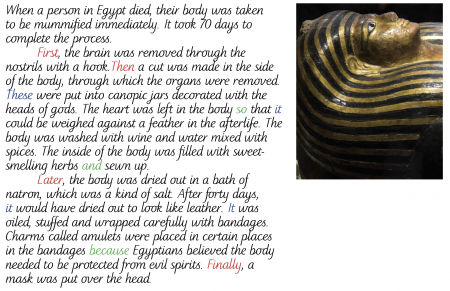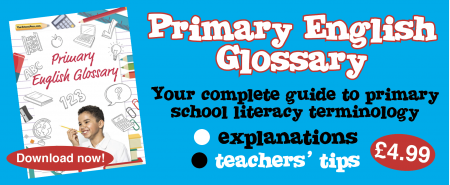Cohesion in Creative Writing
What are cohesion and cohesive devices in writing?
The term 'cohesive devices' refers to the conjunctions, connectives and pronouns used to link the parts of a piece of writing. Using the same verb tense throughout a text also offers 'cohesion'.
Primary-school children may be asked to identify and use cohesive devices in their writing during their time at primary school.

Use of cohesive devices in primary-school writing
The 2014 primary curriculum states that children in Years 5 and 6 need to 'use a wide range of devices to build cohesion within and across paragraphs'.
Basically, when a person's writing has cohesion, an attempt has been made to link clauses, sentences and paragraphs so that the writing 'hangs together'.
This piece of writing shows how cohesive devices can be used:

The time connectives (in red: first, then, later, after, finally) are used to show that this is a process that has several steps and an end goal. These words are also adverbs, because they tell us when something is done.
Pronouns (in blue: these to refer to the organs and it to refer to the body) are used to show that the writer is referring back to a person or object already named.
Conjunctions (in green: and, so, because) are used within sentences to link ideas within a sentence.
Download a FREE Creative Writing toolkit!
- KS1 & KS2 workbooks
- Bursting with fill-in prompt sheets and inspiring ideas
- Story structure tips, style guides and editing suggestions
Which cohesive devices are taught to children throughout primary school?
In Year 1, children will start to write sentences and will be encouraged to use the connective 'and' to join clauses, for example: 'We went shopping and my mum bought lots of nice food.'
In Year 2, children will be encouraged to write longer pieces of writing and will be shown that the verb tense should remain consistent throughout a text (always past tense or always present tense). They will begin to expand on their use of connectives to join clauses of sentences, using connectives such as: when, if, that, because, or, but.
In Years 3 and 4, children will be taught how to compose fiction and non-fiction texts and introduced to the use of paragraphs. They will be expected to use pronouns to link one sentence to a previous one. They will be encouraged to use a wide range of conjunctions, such as: when, if, because, although. They will start to use fronted adverbials, which can help with cohesion when they are related to time (for example: First of all, After all the drama had unfolded, At the end of the meal etc.)
The aim of the above teaching is to help children get to a point in Year 5 and 6 where they can produce writing that shows a range of devices to aid cohesion.

Ways in which teachers teach cohesive devices
- By reading texts and drawing attention to various features.
- Through marking children's work; for example, they may show a child how they could join two short sentences through the use of a conjunction, or they may point out where a tense should stay consistent.
- By teaching 'stand-alone' lessons where a child needs to do some sentence-level work on conjunctions, pronouns or adverbials. There may be lists up in the classroom to offer writing prompts.
- By encouraging children to read a piece of work they have written and improve it to make it more cohesive. Sometimes children are put into pairs to do this, so that one can act as a 'critical friend' to the other.
Source: https://www.theschoolrun.com/what-are-cohesion-and-cohesive-devices-in-writing
0 Response to "Cohesion in Creative Writing"
Post a Comment